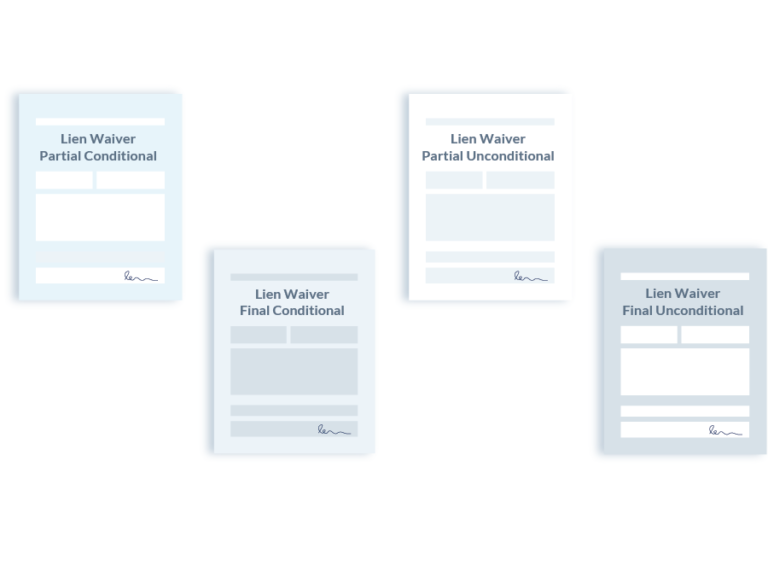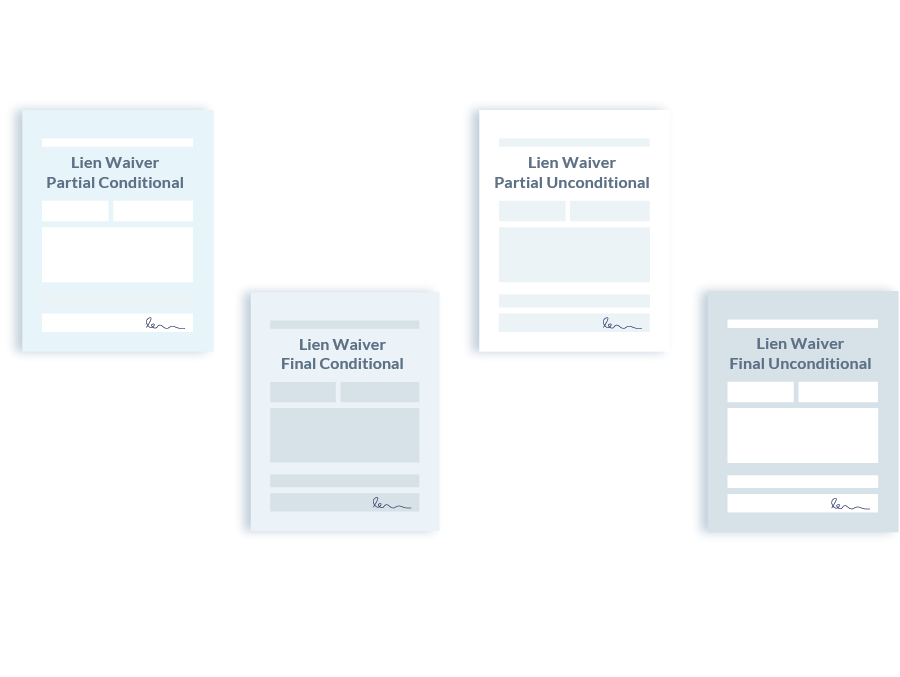

These docs can be confusing, but they don't need to be. Find answers to some frequently asked questions below.
![]()
The waiver rules, forms, and specifics are different in every state. This map gives you an overview of some lien waiver requirements across the country.
![]()
Make sending or collecting your next waiver super easy. Do it free with Levelset, and access all of our free forms.

Enjoy a series of videos that try to explain lien waivers as simply as possible so you can exchange waivers confidently.

Learn how to make sending, collecting, and tracking lien waivers easy and stress-free with Levelset's Waiver Automation.
Lien waivers are documents exchanged at the time of payment in the construction industry. Typically, the party making payment requires the party receiving payment to sign a lien waiver. These documents are important to construction lenders, general contractors, subcontractors, suppliers, and others.
In some places, they are also called lien releases. For example, California calls the waiver form a “Lien Waiver and Release.” But don’t get them mixed up: there’s a difference between a lien waiver and a lien release.
Waivers act like a “receipt” of payment. It is evident that a job participant has received payment, and therefore, will not file a mechanics lien on the job for non-payment. The person or company signing is “waiving” any future lien rights in the project.
Across the United States, there are generally four types of waivers:
It’s important to understand the differences and to use the right one for your payment situation. Learn more about these 4 different lien waivers in our Ultimate Guide to Lien Waivers. You can also learn more about these 4 types of waivers in this short video.
Those making payments on a job desire signed waivers to protect against mechanics lien being filed against the project. Since a mechanics lien filing presents financial and contractual problems on a construction project, general contractors and property owners benefit from withholding payment until certain that a lien will not be filed.
Therefore, you should always request a lien waiver whenever making payment to a contractor, subcontractor, or supplier on a job. Requesting a waiver can be quite simple, even though tracking and managing all of your requests is an administrative pain. You can do it orally, in-person, by email, or electronically. You can electronically request a lien waiver right now—for free—by clicking here.
Those receiving payment on a job may need to review and sign a waiver before getting paid. Reading, managing, and responding to requests is an administrative step that slows down the payment process. The exchange also presents legal and financial risks, as it’s unfortunately common to sign over-broad or dangerously vague lien waivers that waive more rights than bargained for (Read: Should I Sign That Lien Waiver!?).
Contractors & Suppliers can make payment go faster by getting very good and fast at executing and sending out lien waivers. You can electronically send a lien waiver right now – for free.
These documents are pervasive on construction jobs. They are exchanged millions and millions of times on jobs across the country every year. Some companies have departments of people dedicated to signing and shipping, or tracking and receiving, waivers. And for this reason — because these documents are so frequently exchanged — the document is usually prepared, signed, and passed along without much fanfare or analysis. But the laws and cases can cause complications. A variety of factors can really impact everyone’s rights on the job or can invalidate the waiver altogether.

Everything contractors & suppliers need to know about lien waivers. Guides, FAQs, form templates, and tools to make lien waivers easy and fast for you.
Scott Wolfe Jr. Publisher Name Publisher LogoWaiver rules, forms, and requirements can be confusing. Here are some frequently asked questions to help.
First, you need to know the basics. That these documents are exchanged at the time of payment, and are a way for parties making payment (such as owners, lenders, and contractors) to mitigate the risk that a mechanics lien will be filed on the job.
Second, you need to know that the docs are quite complicated. These are pretty complicated docs that are subject to complicated rules. Accordingly, tread carefully.
Third, you need to know the specific rules of your state. It's really important to know what specific requirements you must meet in your specific state. That is important because waivers are definitely not a one-size-fits-all thing.
We have a lot of state-by-state requires (See the map below for waiver rules at a glance, and click on your state to get more detailed information.
Almost everyone needs and uses waivers, or should.
These docs are ubiquitous on construction projects and are used throughout the construction payment process. Waivers are requested and provided alongside nearly every pay application or invoice, and are a constant source of administrative burden for most construction participants.
Anyone working or supplying to a construction project can file a mechanics lien in the event that they are not paid. And, accordingly, may be required to waive those rights to get paid. This is where waivers come in. They serve as proof of payment and protect against liens being filed related to that payment.
In many circumstances, contractors and suppliers will be required to provide a lien waiver in exchange for payment. This is not only common practice, but is specifically set out as an acceptable procedure by statute.
The tricky part is figuring out which specific document to exchange, and timing it correctly.
Deciding which form to use can be confusing. And there are 3 independent considerations:
1. Is a specific document required in your state?
Some states regulate the lien waiver forms used in that state. Jobs in these states must use these statutory forms. There are 12 states that require specific waiver forms.. You can see those states in the map below.
2. What type of payment is being made, and has it been made?
The second consideration requires you to match the lien release form you'll use with the payment itself. Is this a contractor or suppliers last and final payment for a job? Or is it one in a series of payments to the contractor or supplier (i.e. a "progress" payment)? There are usually different waiver forms for each of these. The "final" waiver will waive any and all lien rights on the job. The "progress" waiver will only waive rights for the identified payment period.
Related to this consideration is the question of whether the payment has been made. If the payment has already been exchanged and money is transferred, the parties will want to sign an "unconditional" lien waiver. If the payment has not yet been exchanged, the parties should sign a "conditional" lien waiver. We explored this "conditional v. unconditional" timing wrinkle in Unconditional v. Conditional Lien Waivers..
The third consideration is whether specific waiver (or "lien release" forms) are required by other job stakeholders. Sometimes, a construction lender, property developer, or general contractor will require specific lien waiver forms. Contractors and suppliers must navigate these specific requirements with the other two considerations. This can sometimes be problematic.
It is very common for people to use different terms for lien waivers. This is especially true as you move from one market (i.e. Florida) to another (i.e. California). Lien waivers are sometimes called a bunch of different things, such as releases, lien releases, waivers, lien receipts, conditionals, etc. So long as everyone knows what they're referring to, any of these terms are fine. We prefer the most popular and clear one: lien waivers.
However, this can become real confusing because these other terms can mean other things, too. So, for example:
The Lien Release: This can also refer to the release and cancellation of a filed mechanics lien.
Waiver of Lien Rights: This can also refer to a waiver within a construction contract of lien rights.
In summary, the term "lien release" or "release" is very frequently used to refer to a lien waiver. If you care to learn more about this, you can read this article: Lien Waiver vs Lien Release: What’s the Difference?
Since waivers are exchanged with every invoice and payment in construction, the exchange process can be really cumbersome. In fact, the lien waiver process is famous for being cumbersome.
The truth is there isn't a silver bullet to make this process easy. The process is hard. It's just hard.
The trick is to: (1) Make it as easy as possible; and (2) To do it right.
The best way to keep track of all the lien waiver requests floating around is to employ a system to help you better handle lien waivers.
Most likely, the answer is no.
Somehow, a culture of notarization has developed in the industry. It's remarkably common for pay applications and lien waivers to "require" notarization. But, the truth is, they rarely require notarization.
Only 3 states require lien waivers get notarized: Texas, Wyoming, and Mississippi. And actually, in WY and MS, it's not even that clear. Only Texas' law is explicit that notarization is truly, actually required.
For everywhere other than TX, WY, and MS. notarizing your lien waivers is a waste of time and money. A complete and total waste. And in fact, getting a lien waiver notarized when it's not required may actually invalidate it!! The full notarization debacle is explored in more detail in this article, Do Lien Waivers Need To Be Notarized?
So you have a lien waiver in-hand and are noticing that it's a bit complicated? Worried about putting your John Hancock on the waiver and then signing away some rights? Or worried that you're not protected if the lien waiver doesn't say such and such? This is normal. Lien waivers are confusing documents, and the language can be confusing and full of legal terminology.
You'll want to be careful with lien waiver language. Here is a guide to help you better understand: Common Lien Waiver Language and What it Means for You.
Lien waivers are generally used as part of the construction payment process, and provided in exchange for payment. Accordingly, lien waivers can be exchanged multiple times on each project, along with every progress payment.
In many circumstances, contractors will require lien waivers to be provided from sub-tier parties before making payment.
There are also different types of lien waivers, discussed more in-depth below. The specific type of lien waiver to be used can depend on the circumstances surrounding the payment/waiver exchange. Unconditional waivers are more dangerous to use than conditional waivers because unconditional waivers are effective immediately when signed, regardless of whether payment is actually received. The best, and safest, course of action is to use conditional waivers until payment has actually cleared.
They may. In 12 states, lien waiver forms are specifically set forth by statute. In those states, in order for a lien waiver to be valid it must (substantially) follow the form provided by the state.
In every other state, however, the rules surrounding lien waivers are much less restrictive (if there are really any rules at all). In these states, there are few, if any, restrictions on what can be included on waivers, and the waiver can be in generally any form agreed between the parties. In many circumstances, the party requesting the waiver can practically mandate the form of the waiver to be executed and provided by the party receiving payment, since payment may be relatively contingent upon the receipt of a signed waiver.
They may. As noted above, the term “lien waiver” is generally used to apply to waivers of any statutory security interest protecting construction payment. There is no general distinction between waiving mechanics lien rights and waiving bond claim rights. While there is not really any specific mandate requiring different language on a waiver of the right to make a bond claim as opposed
Yes. In most states, lien waivers can be distinguished into 4 distinct types: Conditional Partial/Progress Waivers; Unconditional Partial/Progress Waivers; Conditional Final Waivers; and Unconditional Final Waivers. It’s important to note that, since the majority of states do not regulate lien waivers at all, the actual language used on forms may be standardized, and the form's category may be unclear.
Conditional Waivers
There are two types of conditional waivers: partial conditional and final conditional. As the name suggests, conditional lien waivers waive lien rights on the condition of actual receipt of payment.
Getting paid on a construction project creates a frustrating Catch-22 scenario. The paying party wants a lien waiver before making the payment, and the receiving party wants to receive the payment before handing over the lien waiver. The solution to this standoff is to use the “conditional” set of waivers. The waiver can be provided prior to payment being received but is only effective when the condition of payment being received is satisfied. As the name suggests, progress/partial waivers are used when further payments are expected on the project, and final waivers are used when no further payments will be made.
Unconditional Waivers
Unconditional waivers operate the same with respect to partial/progress and final types, but are effective immediately upon execution and delivery with no further conditions required. Unconditional lien waivers are completely effective and enforceable the instant they are signed, no matter if payment was actually received or not. This makes them dangerous for parties receiving payment to use prior to the payment actually being in hand.
Making a mistake with a lien waiver can have enormous consequences. The most common mistake with respect to lien waivers is not paying close enough attention to the language on the lien waiver. This can result in completely waiving lien rights prior to receiving payment, waiving other rights in addition to lien rights, waiving lien rights to a greater amount of money than intended, or accidentally creating additional liability.
There’s an infamous case out of Texas involving a company called Zachry Construction that illustrates some of these dangers. In that case, Zachry ended up losing millions of dollars because they signed an overreaching lien waiver.
Zachry Construction did work and was owed money for it. To receive a payment, they were required to sign lien waivers, as is normal. However, a disagreement about something other than the exchanged payment drug on for a long time, and racked up a bunch of attorneys’ fees. The lien waiver document that Zachry signed in order to receive payment, and which really had nothing to do with the dispute, ended up being a disaster for Zachry because it had provisions within it waiving the rights to assert any defenses. A simple mistake ended up costing millions of dollars.
Lien waiver mistakes can have significant consequences on the other side of the spectrum, as well. Parties requesting lien waivers and then making payment must also be vigilant with respect to the waivers provided. If the work is being done in a state with a statutory lien waiver form, for instance, using a different form (even if appropriate and routinely used in another state) can result in an invalid lien waiver. This means that a lien waiver can be obtained, and there can still be a lien filed on the project. Additionally, to fully protect against lien exposure, a party should collect lien waivers from everysub-tier party, i.e. the entire payment chain.
Sometimes, contractors, owners, lenders, and others on a job will require a lien waiver just because they think they have to! It is actually pretty common for this document to be requested, even requested in a particular format, and for that request to hold up the payment process. all the while, with the parties not really understanding why they want the document in the first place. Yikes!
So, you may actually "need" a waiver just for that -- because the person making payment is demanding it.
If you are getting paid, in fact, you don't otherwise need a lien waiver. The waiver does nothing for you. You only need it if someone else is requiring it before giving you payment.
If you are the party making payment, then you need a lien waiver to protect yourself against having to pay for the construction work twice. However, pay close attention to the types of waivers you get and where you get them from. You don't just need any waiver. You need the right waiver, from the right people. And this can be tricky. We explored this in more detail here, How to Handle Requesting & Tracking Lien Waivers.
Very broadly, lien waivers are either conditional or unconditional. If you can't figure out which one is in front of you. STOP RIGHT THERE! You need to know this. It's critical.
The "unconditional" waiver is a waiver of any and all lien rights that a party has on a job, and the waiver is effective regardless of whether payment has or has not been made. This is in contrast to a "conditional" waiver, which is only effective after payment is made on the job.
We have purchased material from a PA based corporation and have requested a conditional release upon payment. The Pa corporation is stating that it is.
I am a subcontractor in Texas who has recently gone through arbitration. The Arbitrator found that we would have been entitled to escalation, however we.
My company is a construction management firm, doing a small back up LP tank and generator for a single family house